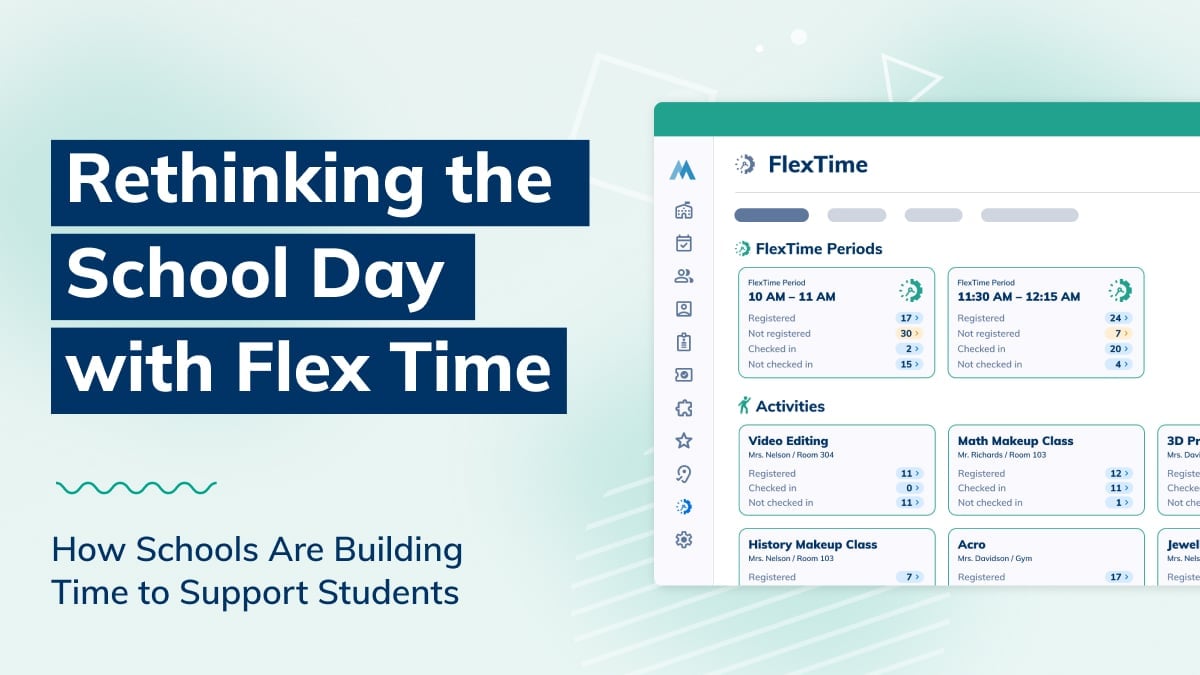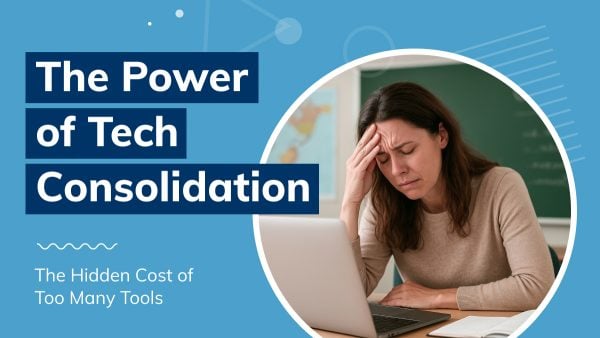In an education system increasingly challenged to meet the needs of diverse learners, one innovation is quietly redefining how schools think about time: the flex period. This isn’t just a minor tweak to the bell schedule—it’s a structural and cultural shift. When implemented with intention, flex periods create powerful opportunities for equity, personalization, and deep student engagement.
They allow schools to reclaim time, not by adding more minutes, but by using the school day more deliberately.
What Is a Flex Period?
A flex period (also commonly known as flex time, WIN time, or an enrichment period) is a structured block of time, typically 20–45 minutes, built into the school day. It’s not a study hall or a catch-all. It’s intentional time designed to support students through:
- Academic Support
(e.g., Algebra re-teach groups, personalized learning or IEP support) - Enrichment Opportunities
(e.g., clubs or project-based sessions) - Advisory, Wellness & SEL Programming
(e.g., peer discussion circles, coping skills workshops) - Skill-Building & Independent Work
(e.g., organizing digital files, group history project prep) - Behavioral Interventions
(e.g., restorative conversations, reflection sessions after incidents) - Student Choice Time
(e.g., content creation, Jackbox games with friends) - Administrative Time
(e.g., student ID photos, schedule changes)
Each day can look different. One day it’s English intervention; the next, a robotics club. What matters is that the time is flexible, responsive, and designed with students at the center.
Why Schools Are Adopting Flex Periods
This shift isn’t happening in a vacuum. Schools are responding to mounting pressures, unfinished learning, mental health challenges, and the need for individualized support, within the fixed structure of a six-to-eight-hour day. Flex periods are emerging as a scalable solution.
1. Equity Through Access
Flex periods bring intervention and enrichment into the school day, reducing reliance on lunchtime clubs or after-school help—options that often exclude students with transportation challenges, jobs, or caregiving responsibilities. Multiple state departments of education, including Massachusetts, now officially recommend embedding these blocks into the daily schedule to ensure equitable access for all learners.
2. Academic Support
Flex periods give teachers the ability to reteach, assess, and accelerate learning exactly when students need it most. That kind of immediacy is especially critical for students with IEPs, where timely, individualized support isn’t just helpful—it’s required. By embedding Tier 2 and Tier 3 interventions into the regular school day, schools can act before small gaps become major setbacks.
And it’s working. At West Port High School in Florida, course failure rates dropped from 37% to just 3.8% after introducing a daily flex block. A five-year study at a Minnesota high school found similar results: failure rates decreased in 27 out of 47 courses, with statistically significant gains in core subjects like English, Math, Biology, and Spanish.
3. Student Empowerment & Agency
Flex periods give students a voice in how they use their time—whether for academic support, creative exploration, or independent work. That choice builds a sense of ownership and develops skills they’ll need long after graduation. A study by the American Institutes for Research found that students in classrooms emphasizing agency showed higher levels of initiative, persistence, and self-confidence—key traits tied to long-term success.
Similarly, a national RAND Corporation study on personalized learning reported that students in environments offering structured choice and flexibility demonstrated stronger motivation and a deeper connection to their learning. Flex time gives students daily practice managing priorities, setting goals, and taking charge of their progress—core components of empowered learning.
4. Teacher Efficiency and Collaboration
With coordinated scheduling, teachers can rotate responsibilities, host targeted sessions, or use time to collaborate across departments. In MTSS-aligned schools, flex periods often serve as protected blocks for PLCs and grade-level teams to review student data and coordinate interventions. States like South Carolina now recommend embedding this “job-embedded” collaboration into the school day, recognizing that timely, structured teacher planning leads to more responsive and cohesive student support.
5. Student Engagement and School Climate
Flex periods give students structured autonomy during the school day, which can significantly boost engagement and improve school climate. At West Port High School in Florida, participation in clubs and enrichment activities grew from 10% to 60% after implementing a daily flex block, and discipline referrals were cut in half. Schools also report stronger student-teacher relationships, with some advisory programs showing that students identify their advisor as a trusted adult, contributing to better attendance, motivation, and a stronger sense of belonging.
Supporting IEPs Through Flex Periods
Why it matters: Individual Education Plans (IEPs) are legally mandated for students receiving special education services, and delivering timely, personalized support is critical to their success. Flex periods give schools a practical way to meet service minutes during the day, without pulling students from core instruction.
- Push-in and pull-out services
- Dedicated time for progress monitoring
- Social-emotional supports are built in
- Staff collaboration time
- Student-driven planning support
What Makes a Flex Period Work?
Schools that successfully implement flex periods don’t just rework schedules—they rethink culture, systems, and expectations.
Clarity of Purpose
The “why” must be crystal clear. Whether the goal is academic recovery, wellness, or readiness for what comes next, a shared purpose drives every decision—from how time is built into the day to how its impact is measured. Flex time becomes effective when it reflects a deliberate shift in priorities, not just a scheduling adjustment.
Smart Scheduling
Time isn’t added—it’s reimagined. Successful models often find space by adjusting existing blocks, rethinking transitions, or integrating with advisory or planning time. What matters is treating this time as essential, not optional, and protecting it from being deprioritized when the calendar gets tight
System Design
A strong Flex model runs on clear logistics. Assignments, attendance, movement, and communication must be manageable and responsive. Whether supported by technology or paper-based systems, what’s needed is clarity—who goes where, why, and how it adjusts as needs change.
Norms and Training
Flex time introduces new behaviors. Students must know how to make purposeful choices. Teachers must be prepared to guide dynamic groups. Leaders must be ready to adapt systems on the fly. These shifts don’t happen naturally—they’re taught, practiced, and reinforced. When students are supported in setting goals, tracking progress, and making decisions about their learning, they begin to develop habits that translate into long-term persistence and initiative.
Culture of Use
Time is only empowering if it’s used well. Without shared expectations, even the best-designed schedules can lead to disengagement or missed opportunities. Structures like advisory, reflective routines, or gentle nudges help establish that this time is for growth. When students understand that the time is truly theirs and how they use it matters, a sense of ownership is built. Motivation and engagement rise not because they’re told what to do, but because they’ve learned how to decide for themselves.

Research has shown that students in high school advisory programs often identify their advisor as a trusted adult mentor; those students demonstrated higher school engagement and greater gains in academic adjustment than peers who did not form such bonds
What Schools Are Seeing
When time is restructured with intention, the ripple effects reach every corner of the student experience. The benefits of flex periods aren’t isolated gains—they’re signs of a more responsive, student-centered system taking shape.
Trusted Relationships Take Root
Students are building stronger connections with adults—not because of a program, but because the day finally makes space for those relationships to form. That trust shows up in attendance, engagement, and a willingness to ask for help before it’s too late.
Academic Progress Becomes Proactive
Students are staying on track more consistently—not because they’ve changed, but because the system has. With structured time to revisit concepts, ask questions, or reset expectations, academic gaps are addressed before they become failures.
Well-Being Is Built Into the Day
They’re showing up less overwhelmed and more focused. A schedule that honors cognitive breathing room does more than reduce stress—it strengthens executive functioning, emotional regulation, and readiness to learn.
Engagement Feels Authentic
They’re participating with more intent. When students have real choices in how they use part of their day—even modest ones—they feel a greater sense of control. That agency isn’t just a feel-good outcome—it’s a rehearsal for adulthood.
Lifelong Skills Are Practiced Early
But perhaps most powerful is what flex time teaches beneath the surface: how to manage priorities, navigate ambiguity, and take initiative. These are not just academic competencies. They’re foundational skills for any path a student might take next.
Bottom Line
Flex periods aren’t just an improvement to the schedule—they’re a shift toward a school experience that better reflects what students need, how they learn, and who they’re becoming.
Supporting Flex Time Success
The effectiveness of any flex period model depends on how well schools can manage the details behind the scenes—who’s going where, when, and why. Effective use of flex time managers helps simplify that complexity.
- Streamlining Scheduling and Participation: Minga allows schools to support both student choice and teacher-directed sessions. Students can select sessions based on interest or need, while teachers can assign support as necessary. Real-time participation data and attendance tracking help ensure that the right students are in the right places at the right times.
- Connecting Support to the Bigger Picture: By integrating behavior and attendance data into the scheduling process, Minga enables schools to use flex time more strategically—whether that means assigning extra help, following up on missed time, or recognizing positive growth.
- Making the System Visible and Coordinated: Live dashboards and communication tools make it easier for staff and administrators to monitor usage, make adjustments, and stay aligned. This level of visibility supports a culture of accountability while keeping the focus on student success.
Flex time works best when it’s structured, responsive, and easy to manage. Minga helps schools make that possible—quietly powering the systems that let students, teachers, and leaders focus on what matters most.

Looking Ahead: Flex Time as a Lever for Redesign
As schools seek ways to modernize learning and address pressing challenges without stretching budgets or extending the school day, flex periods offer a clear path forward. They align with key educational goals—whether it’s supporting RTI, SEL, IEPs, or college readiness—while giving schools the flexibility to adapt and evolve.
Ultimately, flex time shifts the question from:
“How do we fit everything in?” to “What’s worth making time for?”
And the answer is increasingly clear: time for students—supporting them when they need it most, in ways that reflect their individual needs, interests, and potential.










